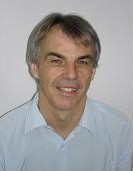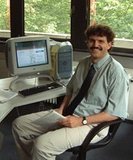Symposium BChemical and Electrochemical Synthesis of Advanced Materials and Nanostructures on Solid Surfaces: Growth Mechanisms, Characterizations and Applications (CESAM) |
|
Symposium BChemical and Electrochemical Synthesis of Advanced Materials and Nanostructures on Solid Surfaces: Growth Mechanisms, Characterizations and Applications (CESAM) |
|
 Symposium Chairman - Dr. Daniel Lincot
Symposium Chairman - Dr. Daniel Lincot
 Symposium
co-chairman - Prof. Gary Hodes
Symposium
co-chairman - Prof. Gary Hodes
 Symposium co-chairman - Prof. Patrik Schmuki
Symposium co-chairman - Prof. Patrik Schmuki
Formation of thin films and nanostructures with
unique properties can be achieved on solid surfaces from solutions by
chemical or electrochemical routes. These processes named Chemical
Bath Deposition, Chemical Solution Deposition, Liquid Phase
Impregnation, hydrothermal growth, Electrodeposition, Anodic
Oxidation are based on a common conceptual ground of interfacial
reactions at the solid-solution interface. The materials can be
semiconductors, oxides, metals, hybrids or nanocomposites in the form
of thin films, porous networks, nanorods or nanotubes arrays, grown
directly by self-organization mechanisms or inside templates like
porous membranes. One can assist in recent years to remarkable
development of these synthesis approaches seeking for advanced
applications in electronics, photovoltaics, lasing, sensors,
photocatalysis, magnetism, batteries...
The aim of the symposium is to promote exchanges between
researchers in this field for
(i) improving a common understanding of the growth mechanisms
involved in the formation processes, from the molecular to the final
structure level, involving interfacial chemical or electrochemical
reactions, the influence of solution composition including additives,
the effect of external parameters like illumination.
(ii) the advanced characterization and optimization of the
properties of the films or nanostructures in relation to the
formation conditions.
(iii) advanced applications in forefront technologies
(iv) theory and modelling
Tentative Topics
- Chalcogenide thin films semiconductors by
chemical deposition and electrodeposition
- Oxide nanostructures by chemical and hydrothermal deposition,
by electrodeposition or anodic oxidation
–
possible session on ZnO
-Porous semiconductors by anodic oxidation
-Hybrid inorganic/organic nanostructures
- Metallic layers and nanostructures by electrodeposition and
chemical deposition (electroless).
-Self assembled, biomimetic and templated growth mechanisms
-Epitaxial growth from solutions
-Advanced applications like Photovoltaics, Photonics,
optoelectronics, magnetics, lighting, sensing, energy storage
Interest, Questions, Suggestions ? Please contact the organizers
The proceedings will be published in Physica Status Solidi.
Instructions for manuscript submission:
Daniel LINCOT
Laboratory of Electrochemistry and Analytical
Chemistry(CNRS-ENSCP-UPMC Paris 6)
Ecole Nationale Supérieure de Chimie de Paris, Paris, France.
e-mail:
daniel–[email protected]
Gary HODES
Department of Materials and Interfaces,Weizmann Institute of
Science, Israel
e-mail:
[email protected]
Patrik SCHMUKI
Department of Materials Science, Institute for Surface Science
and Corrosion (LKO), Friedrich-Alexander University, Erlangen,
Germany
e-mail:
[email protected]